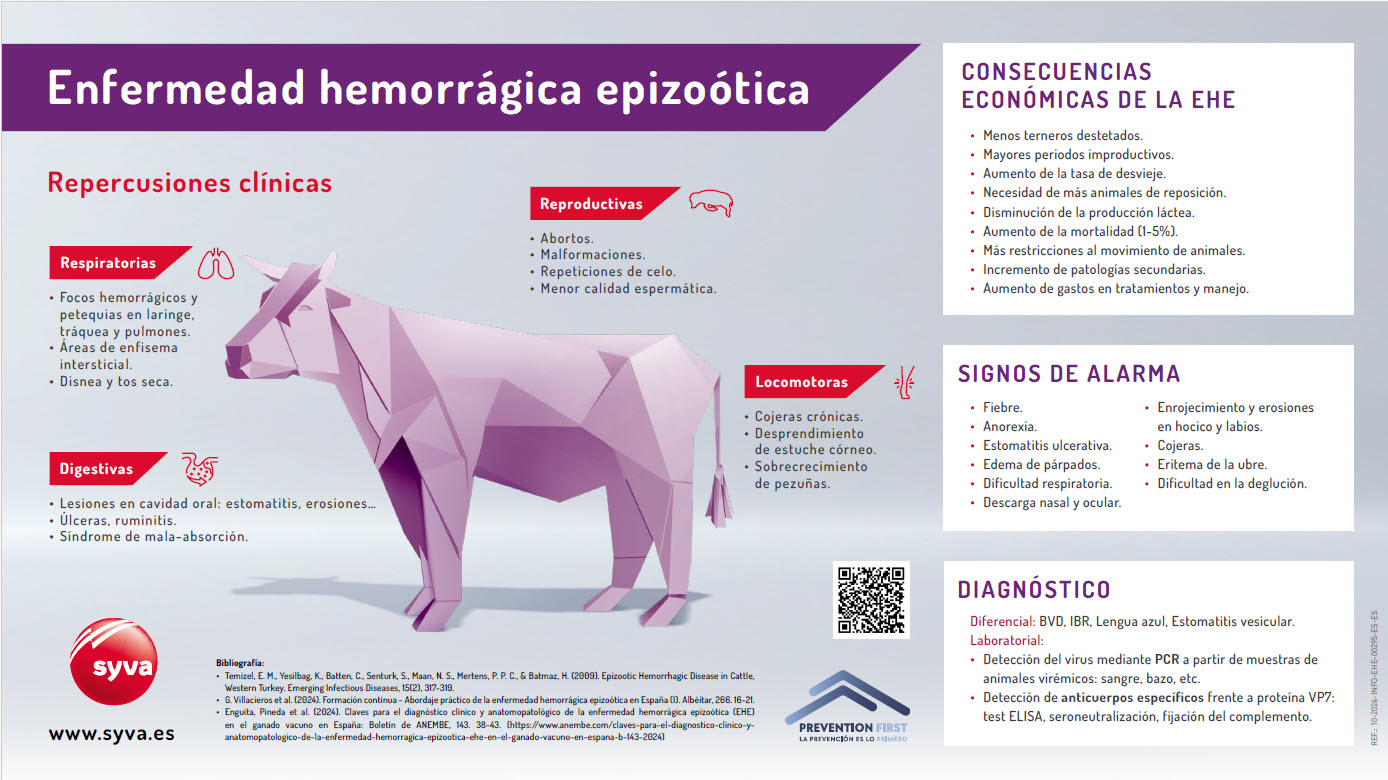Diseases guide: Epizootic haemorrhagic disease

Epizootic haemorrhagic disease (EHD) is a viral disease which until now was mainly known to affect deer, but also impacts production animals, especially cattle. This disease is caused by a virus of the genus ‘Orbivirus’, similar to Bluetongue. Although EHD is commonly associated with deer, it represents a considerable risk to livestock farms, with potential implications for the health and welfare of affected animals and the profitability of farms.
How is epizootic haemorrhagic disease transmitted?
EHD is transmitted mainly by vectors, specifically insects of the genus Culicoides, which are small blood-sucking midges. Transmission occurs when these insects bite an infected animal and then a susceptible animal, inoculating the virus into its blood through their saliva.
The transmission mechanism is therefore identical to that of Bluetongue.
What are the clinical manifestations of epizootic haemorrhagic disease?
In cattle, EHD can manifest with a variety of symptoms, ranging from no clinical signs at all to more severe disease. Infected cattle may present with fever, loss of appetite, lethargy, mouth ulcers and oedema, mainly in the head and neck. In severe cases, severe bleeding and lameness can occur, affecting the productivity of the animals. However, it is important to note that many cattle can carry the virus without showing obvious symptoms, making early detection and on-farm management of the disease difficult.
What are the repercussions of the EHE for cattle farmers?
The impact of epizootic haemorrhagic disease (EHD) on cattle farmers can be significant and covers a number of areas:
- Economic losses: EHD can cause significant economic losses due to reduced meat and milk production, veterinary care costs and possible mortality losses in herds. In addition, the implementation of control and prevention measures, such as vaccination and vector management, entails additional costs.
- Trade restrictions: EHD outbreaks can lead to restrictions on trade and movement of livestock, affecting the ability of farmers to sell or move their animals. This can negatively impact farm incomes and economic viability.
- Herd management problems: Disease can lead to a decrease in the overall performance of animals, affecting their health and welfare. Farmers must devote additional time and resources to managing outbreaks and recovering infected animals.
- Psychological impact and stress: The uncertainty and stress associated with managing an EHD outbreak can affect the welfare of farmers, especially if they face significant economic losses and difficulties in protecting their herds.
Overall, EHD represents a challenge that requires proactive measures and government support to mitigate its effects and protect both animal health and the economic stability of the livestock sector.
How to diagnose EHD?
The diagnosis of epizootic haemorrhagic disease (EHD) is based on a combination of clinical observation, laboratory tests and epidemiological analysis. The main steps in diagnosing EHD include:
- Observation of clinical signs: Affected animals may present with fever, swollen and red mucous membranes, respiratory difficulties, mouth ulcers and lameness. These signs may vary in severity.
- Laboratory tests:
- Serological tests: Used to detect the presence of specific antibodies to EHD virus in blood samples.
- Molecular testing: PCR (polymerase chain reaction) is an effective tool to identify the genetic material of the virus in tissues or blood samples, thus confirming the presence of the virus.
- Histopathology: Examination of affected tissues under the microscope may reveal typical signs of the disease, such as haemorrhages and damage to blood vessels.
- Differential diagnosis: It is important to distinguish EHD from other diseases with similar signs, such as bluetongue, as both are transmitted by insect vectors and can be confused. Other pathologies such as BVD, IBR or vesicular stomatitis should also be considered.
Early and accurate diagnosis is essential to implement control measures and prevent the spread of the virus in herds.
How do we manage the risks and economic impact of EHD?
Managing the risks and economic impact of Epizootic Haemorrhagic Epizootic Disease requires a comprehensive approach that includes preventive measures, outbreak control and economic mitigation strategies. Here are some key actions to achieve this:
- Prevention and control:
- Vaccination: The application of approved vaccines is one of the most effective measures to protect herds and reduce the spread of the virus. Vaccination should be implemented strategically, prioritising areas of highest risk and periods of high vector activity.
- Vector control: Implementing insect vector control programmes is essential. This may include the use of repellents, traps and environmental management to reduce insect breeding areas.
- Biosecurity: Improving biosecurity measures on livestock farms, such as access control and rigorous cleaning of facilities, can minimise the introduction and spread of the virus.
- Detection and rapid response:
- Monitoring and early diagnosis: Implementing active surveillance systems and conducting early diagnostic tests allow outbreaks to be identified and controlled quickly.
- Quarantine protocols: Limiting the movement of infected or at-risk animals helps to prevent the spread of the disease.
- Mitigating the economic impact:
- Advice and training: Providing information and training to farmers on disease management, preventive measures and best management practices reduces the impact on production and the economy.
Effective management of the risks and economic impact of EHD depends on collaboration between farmers, health authorities and animal health experts. The combination of prevention, control and financial support is key to protecting the health of livestock and the economic stability of the livestock sector.
Conclusion
Since 2022, epizootic haemorrhagic disease (EHD) has affected numerous cattle farms in France and Spain, causing major concerns among farmers and health authorities. In view of the spread of this disease, vaccines have recently been approved to protect cervids and cattle. Vaccination is a crucial measure to limit the spread of EHD and reduce its impact on animal health and the economics of livestock farming. The introduction of these vaccines offers new hope for strengthening the resilience of herds and ensuring the continuity of livestock farming activities in affected regions.
Understanding the challenges: Epizootic haemorrhagic disease

Epizootic haemorrhagic disease Infographic: Clinical Impact
Detecting and tackling epizootic haemorrhagic Disease ( EHD) as well as Bluetongue (BT) is a collaborative effort to protect cattle.
